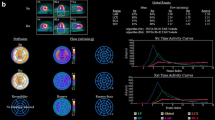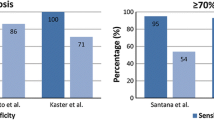Abstract
Relative perfusion imaging using positron emission tomography (PET) has established utility in patients with suspected coronary artery disease (CAD). PET can also be applied to quantify myocardial flow. Kinetic models are fit to dynamic measurements of tracer flux, which then yield quantification of the biological process. Such evaluation may enable diagnosis of early CAD, diffuse CAD, or microvascular disease in nonatherosclerotic heart disease. Whether this approach adds to current perfusion imaging and leads to meaningful alterations in therapy remains to be determined. This review focuses on recent aspects of PET quantitative analysis and key features needed to translate this emerging technique into routine clinical practice.
Similar content being viewed by others
References and Recommended Reading
deKemp RA, Yoshinaga K, Beanlands RS: Will 3-dimensional PET-CT enable the routine quantification of myocardial blood flow? J Nucl Cardiol 2007, 14:380–397.
Kaufmann PA, Camici PG: Myocardial blood flow measurement by PET: technical aspects and clinical applications. J Nucl Med 2005, 46:75–88.
Muzik O, Beanlands RS, Hutchins GD, et al.: Validation of nitrogen-13-ammonia tracer kinetic model for quantification of myocardial blood flow using PET. J Nucl Med 1993, 34:83–91.
El Fakhri G, Guerin G, Sitek A, et al.: Absolute myocardial blood flow quantification in Rb-82 cardiac PET using generalized factor and compartment analysis: a reproducibility study. Eur J Nucl Med Mol Imaging 2006, 33:S217.
Lortie M, Beanlands RS, deKemp RA, et al.: Quantification of myocardial blood flow with 82-Rb dynamic PET imaging. Eur J Nucl Med Mol Imaging 2007, 34:1765–1774.
Anagnostopoulos C, Dorbala S, Di Carli MF, et al.: Quantitative relationship between coronary vasodilator reserve assessed by 82Rb PET imaging and coronary artery stenosis severity. Eur J Nucl Med Mol Imaging 2008, 35:1593–1601.
Di Carli M, Czernin J, Hoh CK, et al.: Relation among stenosis severity, myocardial blood flow, and flow reserve in patients with coronary artery disease. Circulation 1995, 91:1944–1951.
Chareonthaitawee P, Kaufmann PA, Camici PG, et al.: Heterogeneity of resting and hyperemic myocardial blood flow in healthy humans. Cardiovasc Res 2001, 50:151–161.
Klocke F, Baird M, Bateman T, et al.: ACC/AHA/ASNC Guidelines for the Clinical Use of Cardiac Radionuclide Imaging. J Am Coll Cardiol 2003, 42:1318–1333.
Machac J, Beanlands RS, Di Carli MF, et al.: Positron emission tomography perfusion and glucose metabolism imaging. J Nucl Cardiol 2006, 13:e121–e151.
Camici PG, Crea F: Coronary microvascular dysfunction. N Engl J Med 2007, 356:830–840.
Geltman EM, Henes CG, Senneff MJ, et al.: Increased myocardial perfusion at rest and diminished perfusion reserve in patients with angina and angiographically normal coronary arteries. J Am Coll Cardiol 1990, 16:596–598.
Czernin J, Muller P, Chan S, et al.: Influence of age and hemodynamics on myocardial blood flow and flow reserve. Circulation 1993, 88:62–69.
Duvernoy CS, Meyer C, Seifert-Klauss V, et al.: Gender differences in myocardial blood flow dynamics: lipid profile and hemodynamic effects. J Am Coll Cardiol 1999, 33:463–470.
Uren NG, Camici P, Melin JA, et al.: Effect of aging on myocardial perfusion reserve. J Nucl Med 1995, 36:2032–2036.
Ziadi MC, deKemp RA, Yoshinaga K, Beanlands RSB: Diagnosis and prognosis in cardiac disease using cardiac PET perfusion imaging. In Clinical Nuclear Cardiology: State of the Art and Future Directions, edn 4. Edited by Zaret BL, Beller GA. Philadelphia: Elsevier; In press.
Parkash R, deKemp RA, Ruddy TD, et al.: Potential utility of rubidium 82 PET quantification in patients with 3-vessel coronary artery disease. J Nucl Cardiol 2004, 11:440–449.
Yoshinaga K, Katoh C, Noriyasu K, et al.: Reduction of coronary flow reserve in areas with and without ischemia on stress perfusion imaging in patients with coronary artery disease: a study using oxygen 15-labeled water PET. J Nucl Cardiol 2003, 10:275–283.
Dayanikli F, Grambow D, Muzik O, et al.: Early detection of abnormal coronary flow reserve in asymptomatic men at high risk for coronary artery disease using positron emission tomography. Circulation 1994, 90:808–817.
Kaufmann PA, Gnecchi-Ruscone T, di Camici PG, et al.: Coronary heart disease in smokers: vitamin C restores coronary microcirculatory function. Circulation 2000, 102:1233–1238.
Brush JE Jr, Cannon RO 3rd, Schenke WH, et al.: Angina due to coronary microvascular disease in hypertensive patients without left ventricular hypertrophy. N Engl J Med 1988, 319:1302–1307.
Di Carli MF, Grunberger G, Janisse J, et al.: Role of chronic hyperglycemia in the pathogenesis of coronary microvascular dysfunction in diabetes. J Am Coll Cardiol 2003, 41:1387–1393.
Burwash IG, Beanlands RS, deKemp RA, et al.: Myocardial blood flow in patients with low flow, low gradient aortic stenosis: differences between true and pseudo-severe aortic stenosis. Results from the multicenter TOPAS (Truly or Pseudo-Severe Aortic Stenosis) Study. Heart 2008, 94:1627–1633.
Neglia D, Michelassi C, Trivieri MG, et al.: Prognostic role of myocardial blood flow impairment in idiopathic left ventricular dysfunction. Circulation 2002, 105:186–193.
Shikama N, Himi T, Yoshida K, et al.: Prognostic utility of myocardial blood flow assessed by N-13 ammonia positron emission tomography in patients with idiopathic dilated cardiomyopathy. Am J Cardiol 1999, 84:434–439.
Olivotto I, Cecchi F, Camici PG, et al.: Relevance of coronary microvascular flow impairment to long-term remodeling and systolic dysfunction in hypertrophic cardiomyopathy. J Am Coll Cardiol 2006, 47:1043–1048.
Cecchi F, Olivotto I, Gistri R, et al.: Coronary microvascular dysfunction and prognosis in hypertrophic cardiomyopathy. N Engl J Med 2003, 349:1027–1035.
Bergmann SR, Fox KA, Rand AL, et al.: Quantification of regional myocardial blood flow in vivo with H215O. Circulation 1984, 70:724–733.
Schelbert H, Phelps M, Huang SC, et al.: N-13 ammonia as an indicator of myocardial blood flow. Circulation 1981, 63:1259–1271.
Wilson RA, Shea M, Landsheere CD, et al.: Rubidium-82 myocardial uptake and extraction after transient ischemia: PET characteristics. J Comput Assist Tomogr 1997, 11:60–66.
Sun KT, Yeatman LA, Buxton DB, et al.: Simultaneous measurement of myocardial oxygen consumption and blood flow using 11-carbon acetate. J Nucl Med 1998, 39:272–280.
Madar I, Ravert H, DiPaula A, et al.: Assessment of severity of coronary artery stenosis in a canine model using the PET agent 18F-fluorobenzyl triphenyl phosphonium: comparison with 99mTc-tetrofosmin. J Nucl Med 2007, 48:1021–1030.
Yu M, Guaraldi MT, Mistry M, et al.: BMS-747158-02: A novel PET myocardial perfusion imaging agent. J Nucl Cardiol 2007, 14:789–798.
Yalamanchili P, Wexler E, Hayes M, et al.: Mechanism of uptake and retention of F-18 BMS-747158-02 in cardiomyocytes: a novel PET myocardial imaging agent. J Nucl Cardiol 2007, 14:782–788.
Choi Y, Huang SC, Hawkins RA, et al.: Quantification of myocardial blood flow using 13N-ammonia and PET: comparison of tracer models. J Nucl Med 1999, 40:1045–1055.
DeGrado TR, Hanson MW, Turkington TG, et al.: Estimation of myocardial blood flow for longitudinal studies with 13N-labeled ammonia and positron emission tomography. J Nucl Cardiol 1996, 3:494–507.
van den Hoff J, Börner AR, Burchert W, et al.: [1–11C]acetate as a quantitative perfusion tracer in myocardial PET. J Nucl Med 2001, 42:1174–1182.
Hutchins GD, Schwaiger M, Rosenspire KC, et al.: Noninvasive quantification of regional blood flow in the human heart using N-13 ammonia and dynamic positron emission tomographic imaging. J Am Coll Cardiol 1990, 15:1032–1042.
Hesse B, Tagil K, Cuocolo A, et al.: EANM/ESC procedural guidelines for myocardial perfusion imaging in nuclear cardiology. Eur J Nucl Med Mol Imaging 2005, 32:855–897.
Beyer T, Townsend DW, Brun T, et al.: A combined PET/CT scanner for clinical oncology. J Nucl Med 2000, 41:1369–1379.
Einstein AJ, Moser KW, Thompson RC, et al.: Radiation dose to patients from cardiac diagnostic imaging. Circulation 2007, 116:1290–1305.
Yokoyama I, Momomura S, Ohtake T, et al.: Improvement of impaired myocardial vasodilatation due to diffuse coronary atherosclerosis in hypercholesterolemics after lipid-lowering therapy. Circulation 1999, 100:117–122.
Guethlin M, Kasel AM, Coppenrath K, et al.: Delayed response of myocardial flow reserve to lipid-lowering therapy with fluvastatin. Circulation 1999, 99:475–481.
Baller D, Notohamiprodjo G, Gleichmann U, et al.: Improvement in coronary flow reserve determined by positron emission tomography after 6 months of cholesterol-lowering therapy in patients with early stages of coronary atherosclerosis. Circulation 1999, 99:2871–2875.
Schneider CA, Voth E, Moka D, et al.: Improvement of myocardial blood flow to ischemic regions by angiotensinconverting enzyme inhibition with quinaprilat IV: a study using [15O] water dobutamine stress positron emission tomography. J Am Coll Cardiol 1999, 34:1005–1011.
Parodi O, Neglia D, Palombo C, et al.: Comparative effects of enalapril and verapamil on myocardial blood flow in systemic hypertension. Circulation 1997, 96:864–873.
Akinboboye OO, Chou RL, Bergmann SR: Augmentation of myocardial blood flow in hypertensive heart disease by angiotensin antagonists: a comparison of lisinopril and losartan. J Am Coll Cardiol 2002, 40:703–709.
Fallen EL, Nahmias C, Scheffel A, et al.: Redistribution of myocardial blood flow with topical nitroglycerin in patients with coronary artery disease. Circulation 1995, 91:1381–1388.
Bennett SK, Smith MF, Gottlieb SS, et al.: Effect of metoprolol on absolute myocardial blood flow in patients with heart failure secondary to ischemic or nonischemic cardiomyopathy. Am J Cardiol 2002, 89:1431–1434.
Zervos G, Zusman RM, Swindle LA, et al.: Effects of nifedipine on myocardial blood flow and systolic function in humans with ischemic heart disease. Coron Artery Dis 1999, 10:185–194.
Kaufmann PA, Gnecchi-Ruscone T, Camici PG, et al.: Coronary heart disease in smokers: vitamin C restores coronary microcirculatory function. Circulation 2000, 102:1233–1238.
Schächinger V, Britten M, Zeiher AM: Prognostic impact of coronary vasodilator dysfunction on adverse long-term outcome of coronary heart disease. Circulation 2000, 101:1899–1906.
Jenni R, Wyss CA, Oechslin EN, Kaufmann PA: Isolated ventricular noncompaction is associated with coronary microcirculatory dysfunction. J Am Coll Cardiol 2002, 39:450–454.
Camici PG, Gistri R, Lorenzoni R, et al.: Coronary reserve and exercise ECG in patients with chest pain and normal coronary angiograms. Circulation 1992, 86:179–186.
Author information
Authors and Affiliations
Corresponding author
Rights and permissions
About this article
Cite this article
Ziadi, M.C., deKemp, R.A. & Beanlands, R.S.B. Quantification of myocardial perfusion: What will it take to make it to prime time?. curr cardiovasc imaging rep 2, 238–249 (2009). https://doi.org/10.1007/s12410-009-0029-2
Published:
Issue Date:
DOI: https://doi.org/10.1007/s12410-009-0029-2




